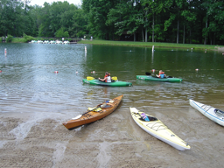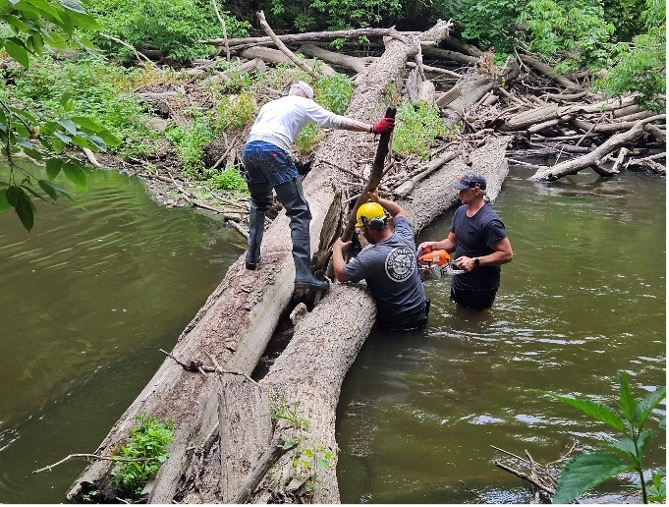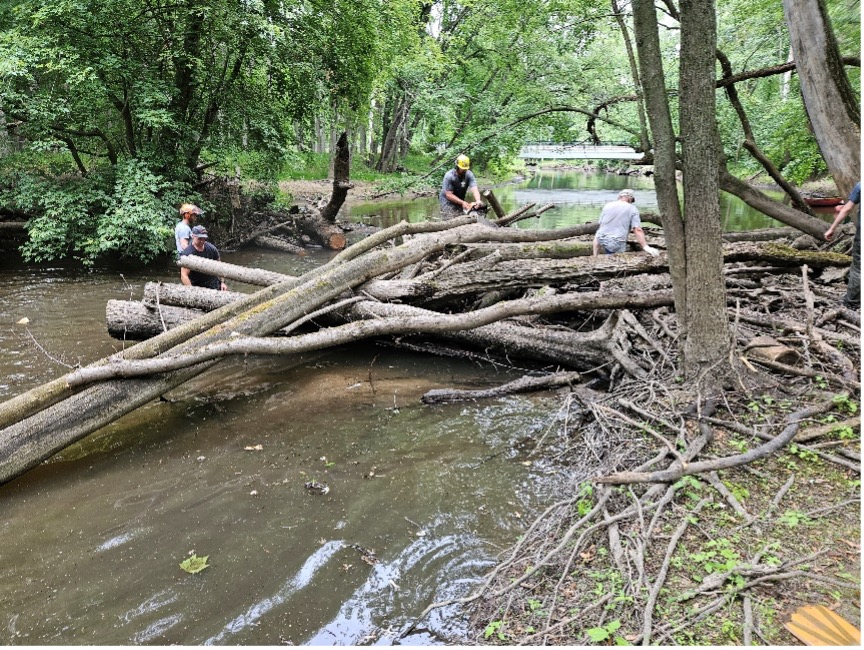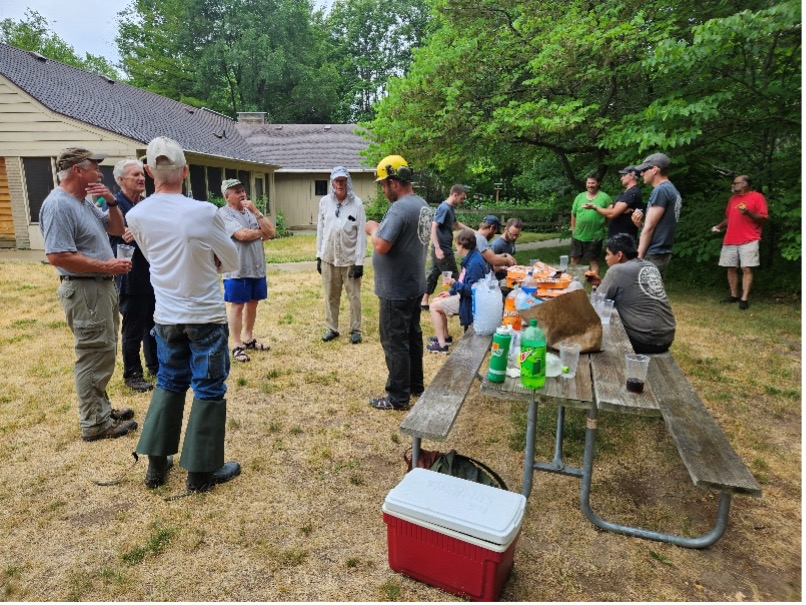Greetings from the President
The annual Youth Sports Event is Sunday August 27 at Burchfield Park from 11:00 am – 2:00 pm. The Lansing Oar and Paddle Club has been a part of this introduction to the kayaking experience there for many years now. We show young people how to get in and out of a kayak and perform basic strokes in a supervised swimming area using Ingham County Parks equipment. Members from the Club have voluntarily brought some of their own boats along in the past to demonstrate the differences and give examples. If you are interested in helping out there is a posting on our Club Meetup site for the event.


The City of Lansing and the Michigan Waterways Stewards with Mike Stout have been actively working on cleaning and clearing the walking trails along the Grand and Red Cedar Rivers, as well as the rivers themselves. You can read more about their work by going to their website at MiWaterwaysStewards.org Their activities on June 8 – 10 resulted in trash and debris being collected and passages cleared on the lower Red Cedar River from Kruger Landing down to the confluence with the Grand River, and the Grand River from there down to Tecumseh Park.
They are also planning another event for September 22 at Rotary Park downtown on the riverfront. Connect to their website highlighted above for more information on how to participate.John Bollman, volunteers, and manpower from Top Notch Tree Care worked on Friday, June 23, on the Red Cedar River from Williamston down past the Harris Nature Center cutting and removing logjams and other natural obstructions. George Stockman has a more detailed report in this newsletter.
Considerable clearing work has been done by others over the years on this section, but there are always new logjams. More work is being planned in the future. Logjams are a natural feature of the Red Cedar River. Paddlers should always be prepared to portage safely around a logjam.
Stay safe,
– Jay Hanks

photo by George Stockman
Red Cedar River Log Jam Work on June 23, 2023
Top Notch Tree Care experts from the Jackson area volunteered to work on log jam removal and a good volunteer crew was hastily recruited by John Bollman to work on the log jams between Williamston and Okemos.
A lot of work was done — more than our LOAPC crews could do in five outings if at all. Crew 1 floated from Williamston down to Roadside Park on Grand River Ave. I think they cut out 3 jams but had a long 6 miles to cover with very little river flow. Crew 2, of which I was a member, cut open 6 large jams from Roadside Park down to Harris Nature Center in a mere 1.7 miles of river. Crew 3 mainly worked from the bank hiking trails from Legg Park back up to Harris. After lunch from 1 to 2 at Harris, most of the volunteers worked together on a total removal of a large jam just downriver from Harris.
The hard cutting was done by the professionals from Top Notch and I was glad to watch and support. Crew 2 pro “Dave” worked long and hard and did things I wouldn’t try myself. He often used plunge cuts on the large horizontal trunks across the river. He would pierce the log using the saw like a sword, plunging through the log about 6in below the top, then saw down to the bottom, sometimes ending up with the chain under water. Then he would return to the top and finish the cut. Of course, his saw was more powerful and had a different chain than what we LOAPC volunteers use. Our Rotary Club and paddler volunteers did mostly the grunt work of moving the logs up out of the riverbed and of transporting the gear and work crew down the river.
Removal of jam 7 was a circus or an opera depending on how one viewed it. Saw men traversed the jammed logs cutting pieces off in a clever order. Waders either removed small pieces and threw them or walked them to shore or tied ropes or chains to the big pieces for the machines to handle. Machine operators bobbed and weaved through the standing trees to get the big logs as high as possible from the riverbed. It was amazing how much weight the machines could handle. Sometimes two separate logs would be tied to the same line and pulled from the river. We “mules” on the shore dodged the machines and moved the small stuff to the same piles. I was tuckered out by 4 PM and content to stay out of the way and rest.
Our support crew was mainly seniors: it was good to see their skill in the boats and energy removing logs from the riverbed; and it was good to make new friends. I enjoyed the results and the optimism of the organizers; however, declarations of the “river being clear from Williamston to Okemos” is naïve. Those of us who paddle often know that the river is only clear until the next storm or until the next leaner loses grip on the bank or loses to the ants or bees eating its belly.
– Story and photos by George Stockman

A passage is cut on the left through a huge jam just downstream from Grand River Ave. Removing all the logs from the riverbed would take another full day.

A jam just below Harris was totally removed by about 12 men and two machines. There is an island at the top left and for years the open channel was on the other side; however, that channel was jammed even more than the left one. (Unfortunately, this left channel will jam again soon when the already dead leaner seen in the upper right falls and collects floaters from upriver.)

Lunch was brought to the Harris Center and was greatly appreciated by the three crews. Crew 2 pro “Dave” is in the center with the yellow helmet.
Red Cedar River Day Planned for September 30
The Red Cedar River Water Trail Committee is planning a day of celebration and activity in Williamston and on the MSU campus on September 30, 2023. Events include guided paddles on selected stretches of the newly-designated water trail, and other activities, including food tents, display booths, and paddle clinics. Keep an eye on their website for additional updates as the date draws closer.
Opinion: Rethinking Bridges, Dams, and Portages
by George Stockman
Recently, there has been a lot of good work in our mid-Michigan area on developing and maintaining water trails. Volunteer organizations such as MGROW, LOAPC, Friends of the Red Cedar, and Rotary Clubs have joined with various overlapping units of local government to define features of our Middle Grand River Water Trail and Red Cedar Water Trail and to work on logistics to create accesses, clear log jams and remove trash from our waterways.
One key issue is missing. There has been progress on signage for bridges and portage trails, which can be seen along our river trails today. We are missing the need to design the portages themselves and integrate that in the design and construction of new bridges and restoration of existing bridges. In my opinion, we need to change both the engineering design processes and the civil laws governing construction. This has been done with wetlands and it is needed with portages.
This recent case study puts sharp focus on the issue. In late 2022, Mike Stout of River Angels organized removal of a large log jam on the Adrian and Blissfield Railroad bridge just downriver from MLK Blvd. Several volunteers joined with RR company employees and a large mass of logs was removed from the riverbed as well as the trash behind it – quite an achievement. However, there was never consideration for a safe portage path in case of a future river-wide jam. The high water of early April 2023 jammed the bridge again and this time when the water level dropped, both spans at river left and river right became unsafe for portaging. At the time of the Hugh Heward event on April 29, there were two tight passages where skilled paddlers could slide over logs in the jam, and most did. However, one experienced team decided to portage on river right. They paddled back up the river bout 20 yards where there was a shallow bank for take-out, and then up a steep rough path to the top of the bank, then over the RR tracks and down to an easy low water put in. I believe that there is old fencing along the tracks with a break in it, probably designed by fishermen. Possibly this path goes through Peckham property.
All bridges are impediments to river travel when jammed. By design, they must be above the water at flood level. To be efficient, their banks are often steep and often have concrete walls. To portage, paddlers must be skilled enough to paddle back upriver to find a safe take-out. A few years ago, just upriver, an old bridge was replaced, and the construction work quickly created a dangerous floating dam and access road. There was no proper warning signage and no planned portage. JH went through on a Friday with help from the construction crew. I went through on Saturday morning and portaged over the new rock road on river right. It was difficult to even walk on that material. Today, those rocks are still there (for portaging) but there is a fence discouraging any access to a walking trail leading to a good dock!
Same thing happened in the construction of the new Okemos Road bridge over this winter of 2023. Crews blocked off the Red Cedar for a few weeks without warning signage and with NO PLANNED PORTAGE. A portaging paddler would have had to find her own way from Ferguson Park through all the construction materials and machines, over a highly trafficked Okemos Rd, and into the Wonch Park construction site. It’s important to mention that there was lots of planning and signage controlling road access by cars and pedestrian access on the sidewalks. There was a similar situation about 15 years ago when the Dobie Road bridge was restored. My daughter and I ran into plastic fencing closing the entire span. No warning, and no portaging signs! We were able to pull the fencing back enough to slide along the abutment and get through. It’s important to note that construction crews understand the situation and have always been helpful when present, but on weekends or evenings paddlers will be on their own.
In summary, bridges [and dams] can be impediments to river use. The need for safe and efficient portage needs to be considered during the design stage of a build or restoration project. Moreover, civil laws are needed to guarantee that proper design and costing is done in the process and that legal access is available, if needed, in adjacent private property. This is especially important in Michigan since we have many small rivers and small cities with multiple bridges and dams and many paddlers.
Copyright © 2023 Lansing Oar and Paddle Club, All rights reserved.
Our mailing address is:
Lansing Oar and Paddle Club
PO Box 26254
Lansing, Mi 48910

